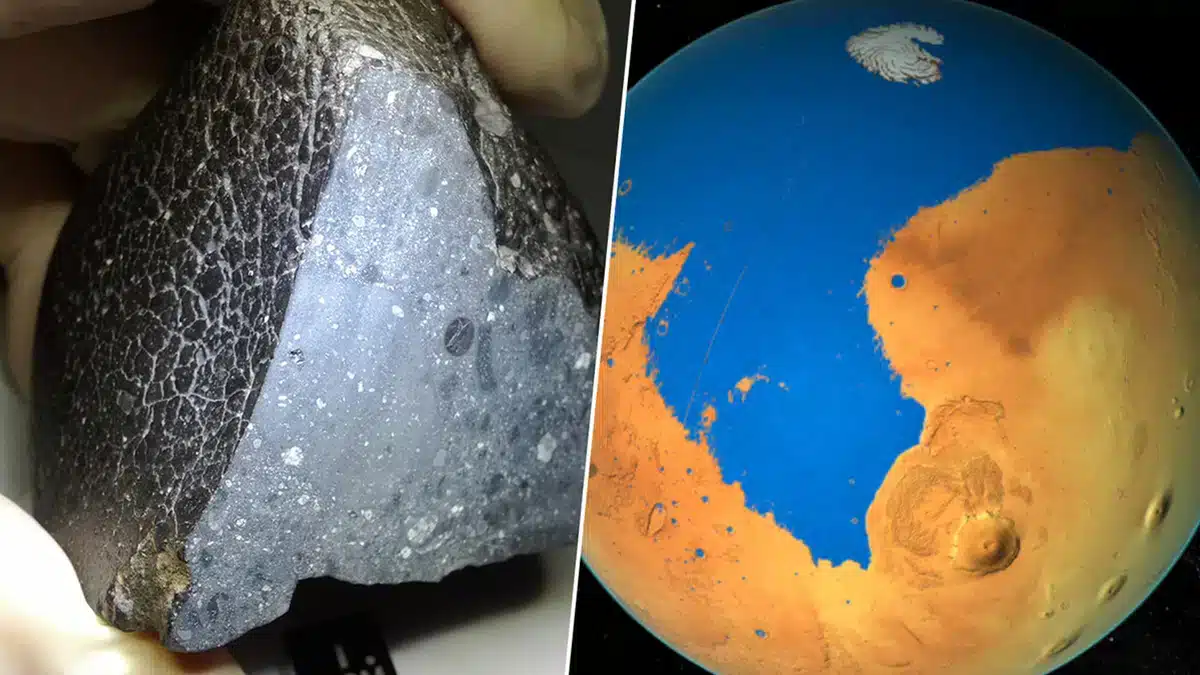The vast expanse of the Sahara desert concealed an extraordinary secret for billions of years until 2011, when Sahrawi nomads stumbled upon a dark, unassuming rock. This mysterious fragment would later revolutionize our understanding of early Martian geology and provide direct evidence of ancient hydrothermal activity on the Red Planet. What appeared to be merely another fallen meteorite became one of the most significant scientific discoveries of the decade.
Ancient Martian rocks reveal planetary secrets
Scientists have identified Northwest Africa 7034, weighing approximately 320 grams, as an exceptional specimen among Martian meteorite collections worldwide. Unlike typical space rocks that originate from recent geological periods, this particular fragment contains minerals spanning vast temporal ranges. The specimen earned the nickname “Black Beauty” due to its distinctive dark appearance and remarkable preservation state.
Advanced analytical techniques revealed that this meteorite originated from Mars’ ancient crust, torn away by a massive impact event millions of years ago. The rock’s composition aligns perfectly with surface observations made by NASA’s rovers, confirming its authentic Martian heritage. Researchers spent over a decade analyzing this specimen before uncovering its most profound secrets about early planetary conditions.
The meteorite’s structure contains a fascinating mixture of ancient and relatively younger components, creating a unique geological timeline. This diversity makes NWA 7034 particularly valuable for understanding Mars’ evolutionary history. Similar to how archaeologists make incredible discoveries after opening rooms sealed for centuries, scientists carefully extracted microscopic samples to reveal billion-year-old information.
Hydrothermal evidence from 4.45 billion years ago
Within the meteorite’s matrix, researchers discovered tiny zircon crystals containing magnetite inclusions that formed under specific conditions. These microscopic features provide compelling evidence of hydrothermal activity during Mars’ pre-Noachian period. The magnetite particles remained trapped within radiation-unaffected zircon regions, indicating simultaneous formation rather than later contamination.
The crystallization process required several critical environmental factors to occur naturally :
- High-temperature water circulation within the Martian crust
- Oxidizing atmospheric conditions supporting mineral formation
- Sustained hydrothermal activity over extended geological periods
- Chemical interactions between water and crustal materials
This discovery fundamentally changes our perception of early Martian surface conditions and planetary evolution. The evidence suggests that Mars possessed active water systems from its earliest formation stages, contradicting previous assumptions about the planet’s arid beginnings. Just as geological processes continue shaping our planet today, similar to how a continent splits to form new oceans, Mars underwent dramatic transformations billions of years ago.
Water content exceeds other Martian specimens
Black Beauty contains water concentrations ten times higher than other known Martian meteorites, making it exceptionally significant for planetary science research. This elevated water content indicates extensive interaction between the original rock and Martian surface water systems. Advanced microscopy techniques revealed how ancient water permeated the rock’s structure during its formation period.
The high water content preservation provides insights into Mars’ early hydrological cycle and atmospheric composition. Scientists can now better understand how water moved through the planet’s crust and interacted with various mineral components. This knowledge helps reconstruct ancient Martian environments and their potential for supporting prebiotic chemical processes.
Modern scientific innovations continue revealing planetary secrets, much like how Japan’s breakthrough in hydrogen production technology demonstrates human ingenuity in understanding natural processes. The meteorite’s water signature represents a crucial piece of evidence for understanding planetary habitability conditions across our solar system.
Implications for astrobiology and future exploration
The discovery strengthens hypotheses about early Martian habitability potential and microbial life emergence possibilities. While tangible evidence of past or present life remains elusive, the confirmed presence of ancient hydrothermal systems creates compelling scenarios for biological activity. These environments on Earth typically support diverse microbial communities thriving in extreme conditions.
Future Mars sample return missions by NASA and international space agencies will build upon these findings to search for more definitive biosignatures. The success of analyzing this 2011 collector’s purchase demonstrates the immense value of returning pristine samples to Earth’s advanced laboratories. Sometimes the most valuable discoveries come from unexpected sources, similar to how people seeking affordable housing opportunities encounter unexpected challenges.
Scientists continue developing sophisticated analytical methods to extract maximum information from limited sample materials. Each grain and crystal within Black Beauty potentially contains additional secrets about Mars’ ancient climate, atmospheric composition, and geological processes. These techniques prove essential for maximizing scientific returns from expensive space exploration missions.
The meteorite’s analysis demonstrates how careful preservation and advanced technology can unlock planetary histories spanning billions of years. Just as simple techniques like placing coins in freezers help prevent serious problems, proper sample storage and handling ensure scientific discoveries remain possible decades after initial collection.










